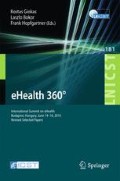Abstract
Job interview is one of the most frequently used methods to assess candidates for employment and it often evokes feelings of anxiety and distress. The principal aim of this study is to use a VR simulation experience to assess the emotional state, and specifically anxiety, of job applicants. Two VR job simulations are proposed to twenty-five participants, before and after a five weeks training aimed to enhance their emotional skills. Results show differences in anxiety experienced by participants exposed to VR-simulated job interviews before and after the trainings and suggest adequacy of VR as an assessment tool sensitive to the changes in internal states of candidates.
Access this chapter
Tax calculation will be finalised at checkout
Purchases are for personal use only
References
Macan, T.: The employment interview: a review of current studies and directions for future research. Hum. Res. Manage. Rev. 19(3), 203–218 (1981)
Ryan, A.N.N., et al.: An international look at selection practices: Nation and culture as explanations for variability in practice. Pers. Psychol. 52(2), 359–392 (1999)
Wilk, S.L., Cappelli, P.: Understanding the determinants of employer use of selection methods. Pers. Psychol. 56(1), 103–124 (2003)
Lievens, F., De Corte, W., Brysse, K.: Applicant perceptions of selection procedures: the role of selection information, belief in tests, and comparative anxiety. Int. J. Sel. Assess. 11(1), 67–77 (2003)
Saks, A.M.: Multiple predictors and criteria of job search success. J. Vocat. Behav. 68(3), 400–415 (2006)
Posthuma, R.A., Morgeson, F.P., Campion, M.A.: Beyond employment interview validity: A comprehensive narrative review of recent research and trends over time. Pers. Psychol. 55(1), 1–81 (2002)
McCarthy, J., Goffin, R.: Measuring job interview anxiety: beyond weak knees and sweaty palms. Pers. Psychol. 57(3), 607–637 (2004)
Ayres, J., et al.: Communication apprehension and employment interviews. Commun. Educ. 47(1), 1–17 (1998)
Jones, D.B., Pinkney, J.W.: An exploratory assessment of the sources of job-interview anxiety in college students. J. Coll. Stud. Dev. 30, 553–560 (1989)
Apa, A.P.A.: Standards for educational and psychological testing. American Psychological Association, Washington (1985)
Fiedler, K.: Emotional mood, cognitive style, and behavior regulation. In: Fiedler, K., Forgas, J.P. (eds.) Affect, Cognition and Social Behavior, pp. 100–119. Hogrefe, Gottingen (1988)
Luce, M.F., Bettman, J.R., Payne, J.W.: Choice processing in emotionally difficult decisions. J. Exp. Psychol. Learn. Mem. Cogn. 23(2), 384 (1997)
Ayres, J., Crosby, S.: Two studies concerning the predictive validity of the personal report of communication apprehension in employment interviews. Commun. Res. Rep. 12(2), 145–151 (1995)
Young, M.J., Behnke, R.R., Mann, Y.M.: Anxiety patterns in employment interviews. Commun. Rep. 17(1), 49–57 (2004)
Riva, G.: Virtual reality in psychotherapy: review. Cyberpsychol. Behav. 8(3), 220–230 (2005)
Anderson, P.L., et al.: Cognitive behavioral therapy for public speaking anxiety using virtual reality for exposure. Depression Anxiety 22(3), 156–158 (2005)
Jo, H.J., et al.: The development of the virtual reality system for the treatment of the fears of public speaking. Stud. Health Technol. Inform. 81, 209–211 (2001)
Pertaub, D.P., Slater, M., Barker, C.: An experiment on fear of public speaking in virtual reality. Stud. Health Technol. Inform. 81, 372–378 (2001)
Slater, M., et al.: An experimental study on fear of public speaking using a virtual environment. CyberPsychol. Behav. 9(5), 627–633 (2006)
Schultheis, M.T., Himelstein, J., Rizzo, A.A.: Virtual reality and neuropsychology: Upgrading the current tools. J. Head Trauma Rehabil. 17(5), 378–394 (2002)
Bandura, A.: Self-efficacy: The Exercise of Control. Freeman, New York (2007)
Villani, D., et al.: May i experience more presence in doing the same thing in virtual reality than in reality? an answer from a simulated job interview. Interact. Comput. 24(4), 265–272 (2012)
Spector, P.E.: Summated Rating Scale Construction: An Introduction. Sage, London (1992)
Spielberger, C.D., Gorsuch, R.L., Lushene, R.E.: State-trait Anxiety Inventory Manual. Consulting Psychologists Press, Palo Alto (1970)
Pedrabissi, L., Santinello, M.: Inventario per l’ansia di « Stato » e di « Tratto »: nuova versione italiana dello STAI Forma Y: Manuale, p. 44. Organizzazioni Speciali, Firenze (1989)
Lang, P.J.: The emotion probe: studies of motivation and attention. Am. Psychol. 50(5), 372–385 (1995)
Russell, J.A.: Affective space is bipolar. J. Pers. Soc. Psychol. 37(3), 345 (1979)
Camm, A., et al.: Heart rate variability. Standards of measurement, physiological interpretation, and clinical use. Eur. Heart J. 17(3), 354–381 (1996)
Barbieri, R., Triedman, J.K., Saul, J.P.: Heart rate control and mechanical cardiopulmonary coupling to assess central volume: a systems analysis. Am. J. Physiol. Regul. Integr. Comp. Physiol. 283(5), 1210–1220 (2002)
Cipresso, P., et al.: Computational psychometrics in communication and implications in decision making. Comput. Math. Methods Med. 2015, 1–10 (2015)
Huang, H.-M., Rauch, U., Liaw, S.-S.: Investigating learners’ attitudes toward virtual reality learning environments: Based on a constructivist approach. Comput. Educ. 55(3), 1171–1182 (2010)
Sims, E.M.: Reusable, lifelike virtual humans for mentoring and role-playing. Comput. Educ. 49(1), 75–92 (2007)
Park, K.-M., et al.: A virtual reality application in role-plays of social skills training for schizophrenia: a randomized, controlled trial. Psychiatry Res. 189(2), 166–172 (2011)
Sharma, P.: Challenges with virtual reality on mobile devices. In: ACM SIGGRAPH Talks (2015)
Villani, D., Riva, G.: Does interactive media enhance the management of stress? suggestions from a controlled study. Cyberpsychol. Behav. Soc. Netw. 15(1), 24–30 (2012)
Author information
Authors and Affiliations
Corresponding author
Editor information
Editors and Affiliations
Rights and permissions
Copyright information
© 2017 ICST Institute for Computer Sciences, Social Informatics and Telecommunications Engineering
About this paper
Cite this paper
Villani, D., Rotasperti, C., Cipresso, P., Triberti, S., Carissoli, C., Riva, G. (2017). Assessing the Emotional State of Job Applicants Through a Virtual Reality Simulation: A Psycho-Physiological Study. In: Giokas, K., Bokor, L., Hopfgartner, F. (eds) eHealth 360°. Lecture Notes of the Institute for Computer Sciences, Social Informatics and Telecommunications Engineering, vol 181. Springer, Cham. https://doi.org/10.1007/978-3-319-49655-9_16
Download citation
DOI: https://doi.org/10.1007/978-3-319-49655-9_16
Published:
Publisher Name: Springer, Cham
Print ISBN: 978-3-319-49654-2
Online ISBN: 978-3-319-49655-9
eBook Packages: Computer ScienceComputer Science (R0)

